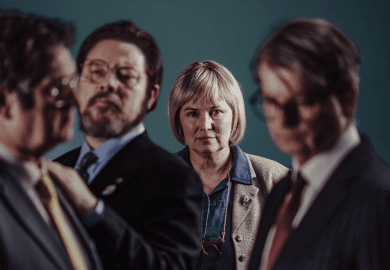NEW YORK—Who could guess that a play consisting only of political talk in Ireland, could hold the interest of an American audience. But, to my mind, the Lyric Theatre production of Owen McCafferty’s “Agreement,” coming from Belfast, holds the audience, and then some.
The play deals with an event from about 25 years ago, during the five-day negotiations of several Irish and British political parties. The hoped-for solution is to curtail the long-lasting violence between Ireland’s north and south.
Six men and one woman—unionists, labor party folks, nationalists, the whole range of Irish politics—are holed up to negotiate the tricky problems. Nations are at stake. Some participants root for Ireland to be a nation separate from Great Britain’s influence. Others want Ireland to join the European Union.
Prime Minister Tony Blair leads the proceedings, but there is constant bickering and dickering between the others, who often pair off in twos or threes to discuss their points of view. The negotiators must keep to the desires of their particular constituents. The latter portions of the play feature Ulster Unionist Party leader David Trimble (Ruairi Conaghan) holding back. He views Sinn Fein leader Gerry Adams (Chris Corrigan) as a “terrorist.”
Trimble is so reluctant in these negotiations that Prime Minister Blair and the others fear that he might walk away, and destroy the whole effort. Secretary of State Mo Mowlam (Andrea Irvine) of Northern Ireland, the only woman in the cast, is the peacekeeper. She tries to calm the nervous participants.
The discussions are sometimes interrupted by the appearance of Bertie Ahern (Ronan Leahy), Taoiseach (or prime minister) of the Republic of Ireland. He enters by means of a noisy, obtrusive helicopter, with papers from the various desks flying around the room; while President Clinton is heard via voice-overs, advising the participants to keep the talks going.

To add to the tension in the room, an ominous, enormous clock overhead signals the passing hours. The negotiations continue way past the midnight deadline, until about 5 p.m. the next day. Finally, an agreement is hammered out although the turning point is unclear, but there is an agreement as a humorous victory dance attests.
The entire cast of six men and one woman, in this Lyric Theatre (Belfast production) of “Agreement,” is of highest quality. Arguably, much of this excellence is due to the fact that Ireland maintains resident acting companies, where actors can work together over time, months or even years. Kudos to the entire cast.
Perhaps most compelling is Martin Hutson as Prime Minister Blair, for his personal charisma and taut acting skill. In addition to those mentioned above, other actors include Richard Croxford as U.S. Senator George Mitchell and Dan Gordon as the nationalist John Hume.
It is obviously due to director Charlotte Westenra’s imagination that this production came about, but this is one of the few plays where the technical work and staff are just as important as the actors and director.
Set and costume designer Conor Murphy created a stage that consists of a large round platform. Above it and in the rear is a large round window. That expanse is broken only by the occasional appearance of the helicopter, which fills the space with wing and noise. All the men wear dark business suits and ties; the one woman wears a neutral-colored jacket and skirt—these possibly to emphasize the somberness of the negotiations.
Sound designer Kate Marlais punctuates each mini-scene with a loud noise or music. It is unsettling and helps maintain the tension. Lighting is designed by Mary Tumelty and video designs are by Eoin Robinson.
The significance of this event is such that Trimble and Hume both received the Nobel Peace Prize for their work in the Belfast Agreement. Though “Agreement” has not received any awards, it should. It is a well-staged dramatization of an important historical event.







